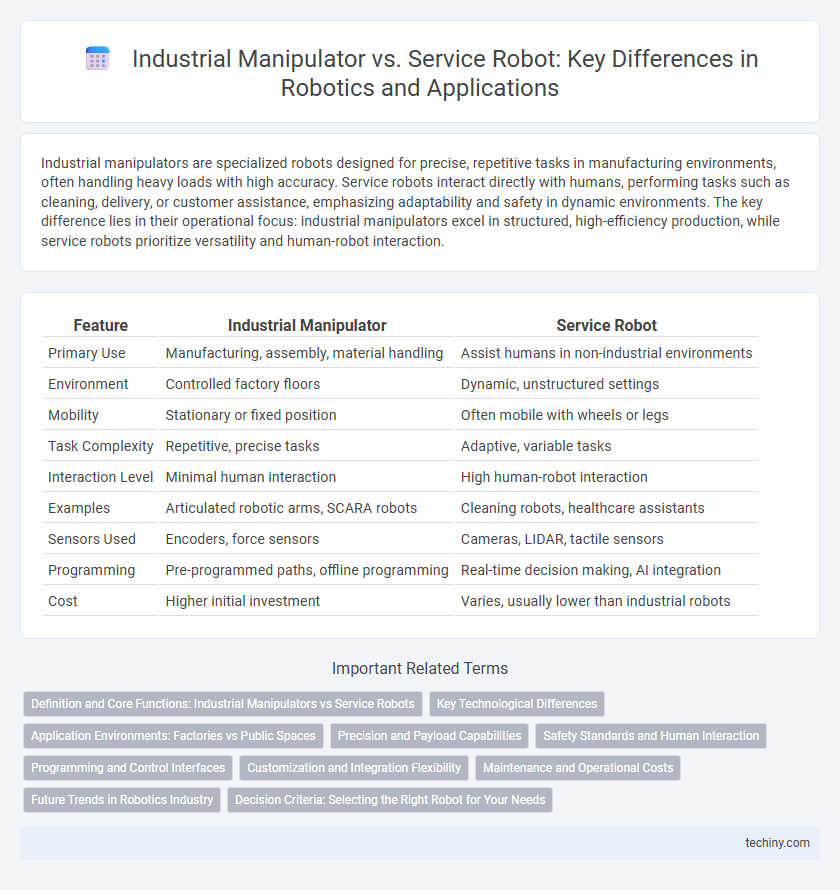Industrial manipulators are specialized robots designed for precise, repetitive tasks in manufacturing environments, often handling heavy loads with high accuracy. Service robots interact directly with humans, performing tasks such as cleaning, delivery, or customer assistance, emphasizing adaptability and safety in dynamic environments. The key difference lies in their operational focus: industrial manipulators excel in structured, high-efficiency production, while service robots prioritize versatility and human-robot interaction.
Table of Comparison
| Feature | Industrial Manipulator | Service Robot |
|---|---|---|
| Primary Use | Manufacturing, assembly, material handling | Assist humans in non-industrial environments |
| Environment | Controlled factory floors | Dynamic, unstructured settings |
| Mobility | Stationary or fixed position | Often mobile with wheels or legs |
| Task Complexity | Repetitive, precise tasks | Adaptive, variable tasks |
| Interaction Level | Minimal human interaction | High human-robot interaction |
| Examples | Articulated robotic arms, SCARA robots | Cleaning robots, healthcare assistants |
| Sensors Used | Encoders, force sensors | Cameras, LIDAR, tactile sensors |
| Programming | Pre-programmed paths, offline programming | Real-time decision making, AI integration |
| Cost | Higher initial investment | Varies, usually lower than industrial robots |
Definition and Core Functions: Industrial Manipulators vs Service Robots
Industrial manipulators are robotic arms designed primarily for manufacturing tasks such as welding, assembly, and material handling, emphasizing precision, strength, and repetitive motion within controlled environments. Service robots perform tasks that assist humans outside industrial settings, including healthcare support, cleaning, and delivery, prioritizing adaptability and interaction in dynamic environments. The core function of industrial manipulators centers on automating production lines with high accuracy, while service robots focus on enhancing human convenience and efficiency.
Key Technological Differences
Industrial manipulators are characterized by precise, high-speed automation designed for repetitive manufacturing tasks, often equipped with rigid arms and end-effectors optimized for material handling, welding, or assembly. Service robots prioritize adaptability, incorporating advanced sensors, AI-driven perception, and machine learning algorithms to operate safely in dynamic human environments for tasks like cleaning, delivery, or healthcare. Key technological differences include the industrial manipulators' emphasis on payload capacity and repeatability versus the service robots' focus on mobility, interaction, and real-time environmental adaptation.
Application Environments: Factories vs Public Spaces
Industrial manipulators are primarily designed for factory environments where tasks such as assembly, welding, and material handling require precise, repetitive motions in controlled settings. Service robots operate in dynamic public spaces, adapting to varying conditions to perform functions like cleaning, delivery, or customer assistance. The distinct application environments influence the design, safety features, and interaction capabilities of each robot category.
Precision and Payload Capabilities
Industrial manipulators excel in precision with repeatability often within +-0.02 mm, enabling intricate tasks such as assembly and welding, and boast high payload capacities exceeding 100 kg for heavy-duty operations. Service robots typically offer moderate precision, around +-0.1 to 1 mm, suitable for tasks like cleaning and delivery, with lower payload capabilities generally under 20 kg to maintain agility and safety. The trade-off between precision and payload reflects the distinct functional demands of industrial automation versus dynamic service environments.
Safety Standards and Human Interaction
Industrial manipulators operate within controlled environments adhering to stringent safety standards such as ISO 10218, minimizing risks through physical barriers and limited human interaction. Service robots prioritize adaptive safety protocols like ISO 13482, enabling safe, close human interaction in dynamic settings such as healthcare or hospitality. Advances in sensor technologies and collaborative robotics (cobots) enhance human-robot interaction by integrating real-time hazard detection and compliance with international safety guidelines.
Programming and Control Interfaces
Industrial manipulators rely on specialized programming languages like RAPID or KRL and use teach pendants or PLC interfaces for precise control, enabling high repeatability in manufacturing tasks. Service robots employ more flexible, user-friendly programming environments such as ROS (Robot Operating System) and support control through mobile apps or voice commands to adapt to dynamic, unstructured environments. The distinction in programming complexity and interface design directly influences deployment efficiency and operational versatility in industrial versus service applications.
Customization and Integration Flexibility
Industrial manipulators offer high customization options tailored to specific manufacturing processes, enabling seamless integration with existing automation systems and production lines. Service robots prioritize flexible integration to adapt to diverse environments and user needs, often featuring modular designs for easy reconfiguration. Customization in service robots focuses more on software adaptability and user interface, while industrial manipulators emphasize hardware precision and robustness.
Maintenance and Operational Costs
Industrial manipulators typically incur higher initial investment and ongoing maintenance costs due to their complex mechanical structures and specialized components. Service robots generally have lower operational expenses, benefiting from modular designs and software-driven updates that reduce downtime and repair needs. Effective cost management depends on operational demands, where industrial manipulators justify expenses through high-precision tasks while service robots optimize routine maintenance activities.
Future Trends in Robotics Industry
Industrial manipulators are evolving with enhanced precision, AI integration, and collaborative capabilities to meet the rising demand for automated manufacturing and assembly processes. Service robots are rapidly advancing in adaptability, human-robot interaction, and autonomous navigation to expand their roles in healthcare, hospitality, and domestic environments. Future trends emphasize seamless interoperability between industrial manipulators and service robots, driven by advancements in machine learning, sensor technology, and connectivity within the Industrial Internet of Things (IIoT).
Decision Criteria: Selecting the Right Robot for Your Needs
Industrial manipulators excel in repetitive, high-precision tasks within manufacturing environments, offering robust payload capacity and integration with automated production lines. Service robots prioritize human interaction, adaptability, and mobility for applications in healthcare, hospitality, and domestic assistance, favoring flexibility over payload strength. Key decision criteria include task complexity, operational environment, payload requirements, and the need for human-robot interaction, guiding the choice between specialized industrial manipulators and versatile service robots.
Industrial manipulator vs Service robot Infographic

 techiny.com
techiny.com